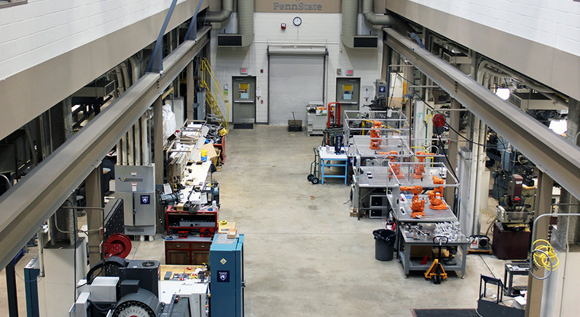Researchers receive grant to investigate ‘super finishing’ of metal AM parts
June 11, 2018

The new super-finishing lab will be installed in the Factory for Advanced Manufacturing Education (FAME) Lab (Courtesy Penn State)
Researchers at Penn State University, Pennsylvania, USA, have received a grant of approximately $535,000 to install a state-of-the-art ‘super-finishing lab’ for metal additively manufactured parts. Funding for the one-year project, titled ‘Super Finishing of Printed Metallic Parts for High Performance Naval Systems’, is being provided by the Defense University Research Instrumentation Program, which operates through the US Department of Defense’s Office of Naval Research.
The new lab is expected to complement the existing subtractive processing technology in the Factory for Advanced Manufacturing Education Lab within the Harold and Inge Marcus Department of Industrial and Manufacturing Engineering. Together, the machinery will provide the subtractive processing capabilities necessary to transform printed parts into components ready for product assembly. The equipment in the FAME Lab will be used for both the instruction of engineering students and the academic research.
Professor Ed De Meter, principal investigator on the project, stated, “The Navy has a strong interest in identifying and researching the technical issues of using 3D printed metal parts for naval applications now and in the future. They want to better understand how to design parts while identifying potential barriers and also benefits that may arise between the metal printing process and any secondary processing that is done to smooth out the surface texture of these parts.”
The functional surfaces of these parts need to have extremely tight geometric control and a very smooth surface finish, he explained. If a part is subjected to a lot of cyclic loading (i.e. force, vibration, etc) and has rough surfaces, it promotes the formation of cracks and premature failure of the parts.
“In parts like those the Navy uses, there are a number of internal passageways involved,” De Meter continued. “If the part is printed and the finish of the passageway is rough, it’s going to interfere with the flow; or if there are loose particles from the printing process in any crevice of the part, and they break free during the application, it can cause not only the part but the entire system to fail.”
De Meter stated that the focus of the initial research proposal is threefold. First and foremost, it is to establish expertise on how parts made using AM processes will react when they are super finished and installed in complex assemblies. That general processing knowledge could then be shared via best practices to the overall community because, according to De Meter, such public information does not currently exist.
Secondly, the team wants to look into the finishing of metal parts that feature tight lattice structures to discover if these finishing processes can be used to polish some of the intricate passageways of the parts. “If we find out there are deficiencies in finishing these parts, which we suspect there will be, that’s where we will want to work on process development,” he stated.
The third component of interest for the researchers is education. The team hopes to create graduate-level courses that could be offered online to employees of those companies who use these finishing processes on metal AM parts. “It’s more convenient and economical for these employees to take some courses online than it would be for a company to pick up the cost of sending them off-site to learn about these technologies,” said De Meter.
















